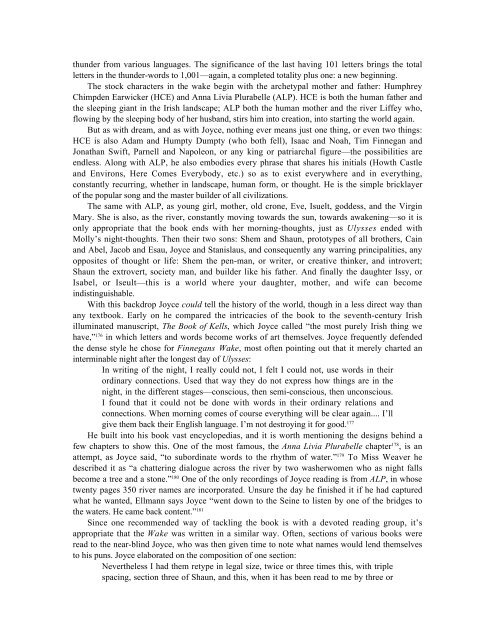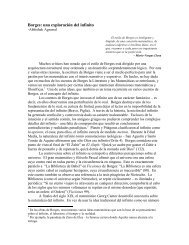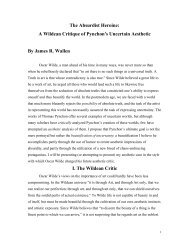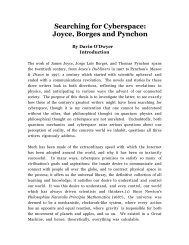And A Very Good Time It Was: A Short Life of ... - The Modern Word
And A Very Good Time It Was: A Short Life of ... - The Modern Word
And A Very Good Time It Was: A Short Life of ... - The Modern Word
You also want an ePaper? Increase the reach of your titles
YUMPU automatically turns print PDFs into web optimized ePapers that Google loves.
thunder from various languages. <strong>The</strong> significance <strong>of</strong> the last having 101 letters brings the total<br />
letters in the thunder-words to 1,001—again, a completed totality plus one: a new beginning.<br />
<strong>The</strong> stock characters in the wake begin with the archetypal mother and father: Humphrey<br />
Chimpden Earwicker (HCE) and Anna Livia Plurabelle (ALP). HCE is both the human father and<br />
the sleeping giant in the Irish landscape; ALP both the human mother and the river Liffey who,<br />
flowing by the sleeping body <strong>of</strong> her husband, stirs him into creation, into starting the world again.<br />
But as with dream, and as with Joyce, nothing ever means just one thing, or even two things:<br />
HCE is also Adam and Humpty Dumpty (who both fell), Isaac and Noah, Tim Finnegan and<br />
Jonathan Swift, Parnell and Napoleon, or any king or patriarchal figure—the possibilities are<br />
endless. Along with ALP, he also embodies every phrase that shares his initials (Howth Castle<br />
and Environs, Here Comes Everybody, etc.) so as to exist everywhere and in everything,<br />
constantly recurring, whether in landscape, human form, or thought. He is the simple bricklayer<br />
<strong>of</strong> the popular song and the master builder <strong>of</strong> all civilizations.<br />
<strong>The</strong> same with ALP, as young girl, mother, old crone, Eve, Isuelt, goddess, and the Virgin<br />
Mary. She is also, as the river, constantly moving towards the sun, towards awakening—so it is<br />
only appropriate that the book ends with her morning-thoughts, just as Ulysses ended with<br />
Molly’s night-thoughts. <strong>The</strong>n their two sons: Shem and Shaun, prototypes <strong>of</strong> all brothers, Cain<br />
and Abel, Jacob and Esau, Joyce and Stanislaus, and consequently any warring principalities, any<br />
opposites <strong>of</strong> thought or life: Shem the pen-man, or writer, or creative thinker, and introvert;<br />
Shaun the extrovert, society man, and builder like his father. <strong>And</strong> finally the daughter Issy, or<br />
Isabel, or Iseult—this is a world where your daughter, mother, and wife can become<br />
indistinguishable.<br />
With this backdrop Joyce could tell the history <strong>of</strong> the world, though in a less direct way than<br />
any textbook. Early on he compared the intricacies <strong>of</strong> the book to the seventh-century Irish<br />
illuminated manuscript, <strong>The</strong> Book <strong>of</strong> Kells, which Joyce called “the most purely Irish thing we<br />
have,” 176 in which letters and words become works <strong>of</strong> art themselves. Joyce frequently defended<br />
the dense style he chose for Finnegans Wake, most <strong>of</strong>ten pointing out that it merely charted an<br />
interminable night after the longest day <strong>of</strong> Ulysses:<br />
In writing <strong>of</strong> the night, I really could not, I felt I could not, use words in their<br />
ordinary connections. Used that way they do not express how things are in the<br />
night, in the different stages—conscious, then semi-conscious, then unconscious.<br />
I found that it could not be done with words in their ordinary relations and<br />
connections. When morning comes <strong>of</strong> course everything will be clear again.... I’ll<br />
give them back their English language. I’m not destroying it for good. 177<br />
He built into his book vast encyclopedias, and it is worth mentioning the designs behind a<br />
few chapters to show this. One <strong>of</strong> the most famous, the Anna Livia Plurabelle chapter 178 , is an<br />
attempt, as Joyce said, “to subordinate words to the rhythm <strong>of</strong> water.” 179 To Miss Weaver he<br />
described it as “a chattering dialogue across the river by two washerwomen who as night falls<br />
become a tree and a stone.” 180 One <strong>of</strong> the only recordings <strong>of</strong> Joyce reading is from ALP, in whose<br />
twenty pages 350 river names are incorporated. Unsure the day he finished it if he had captured<br />
what he wanted, Ellmann says Joyce “went down to the Seine to listen by one <strong>of</strong> the bridges to<br />
the waters. He came back content.” 181<br />
Since one recommended way <strong>of</strong> tackling the book is with a devoted reading group, it’s<br />
appropriate that the Wake was written in a similar way. Often, sections <strong>of</strong> various books were<br />
read to the near-blind Joyce, who was then given time to note what names would lend themselves<br />
to his puns. Joyce elaborated on the composition <strong>of</strong> one section:<br />
Nevertheless I had them retype in legal size, twice or three times this, with triple<br />
spacing, section three <strong>of</strong> Shaun, and this, when it has been read to me by three or





